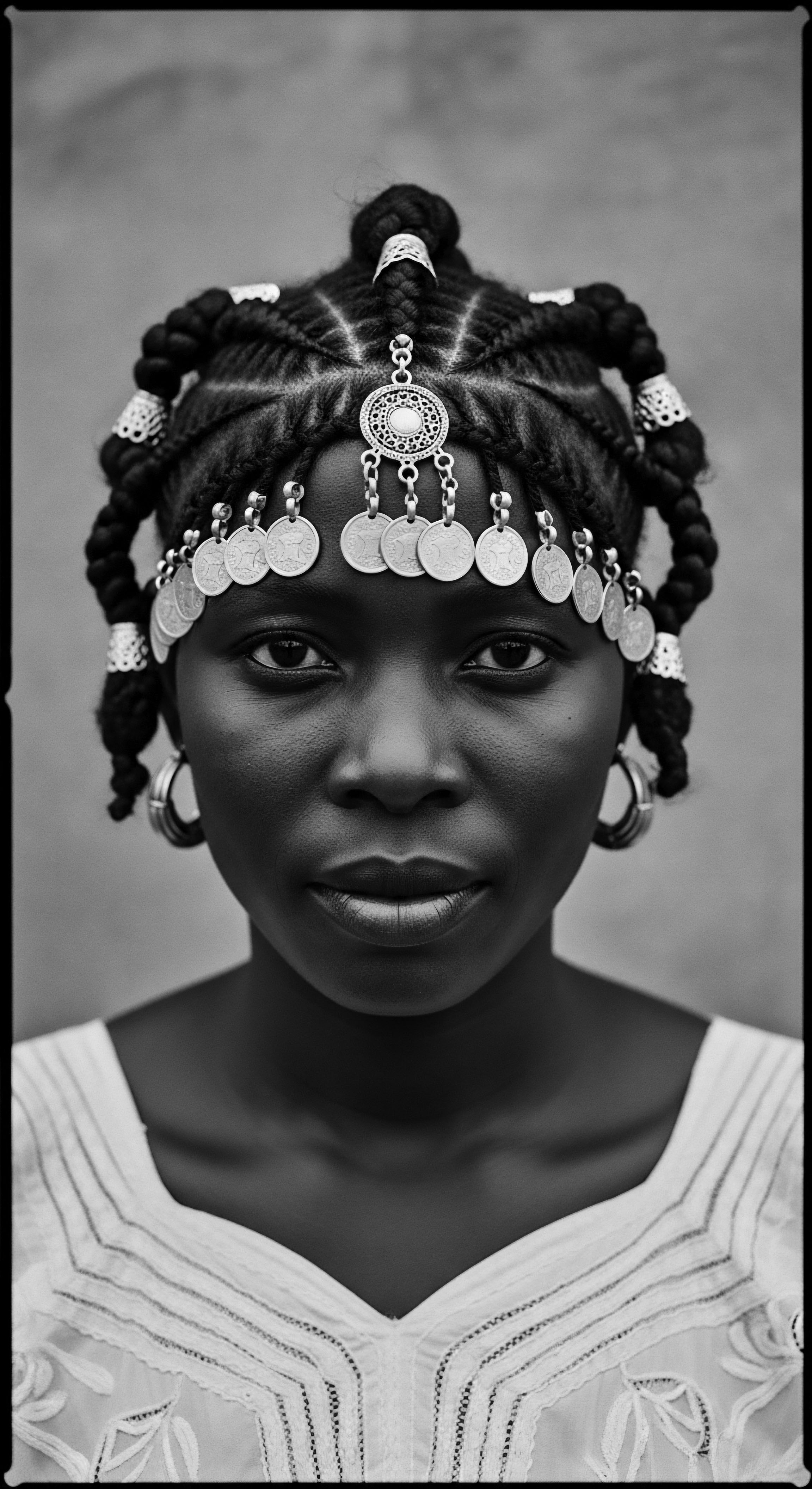
Fundamentals
The Ube Yam, known scientifically as Dioscorea Alata, stands as a profound botanical entity, a vibrant root vegetable whose presence extends far beyond culinary delight. It is a tuber, a starchy storage organ that anchors the plant in the soil, holding within its depths a story of sustenance and significant cultural meaning. The surface often reveals hues ranging from a light lavender to a deep, striking violet, a testament to its rich anthocyanin content, which are the very pigments that bestow its characteristic color. Its form can vary, frequently presenting as a cylindrical shape, though other cultivars might show a more irregular, branching habit.
In its foundational sense, Ube Yam represents a staple food source for countless communities across tropical and subtropical latitudes for millennia. Indigenous peoples throughout Southeast Asia and the Pacific Islands first cultivated this species, long before its dispersal across global trade routes. Its meaning to early agricultural societies was undeniably linked to survival, a reliable source of carbohydrates and vital nutrients, especially during periods of scarcity. The root’s ability to store energy beneath the earth made it a symbol of enduring life and provision within ancestral economies.
The Ube Yam, Dioscorea alata, embodies a deep ancestral connection to the earth’s bounty, providing sustenance and holding profound cultural significance in diverse communities.
Across various cultures, the Ube Yam has long held a cherished status, representing a plant deeply intertwined with the human experience. Its history is not merely one of cultivation; it is a chronicle of how humanity learned to live in concert with the land, coaxing forth nourishment and remedies from the natural world. Ancient civilizations recognized the intrinsic worth of such hardy crops, understanding that the health of the community often depended on the vibrancy of their harvested plants.

Ancestral Echoes of Sustenance
From its earliest domestication, Ube Yam has offered more than mere calories; it provided a sense of continuity and resilience. The act of planting and harvesting the yam became a ritual in itself, connecting generations to the cyclical rhythms of nature. This profound agricultural relationship laid the groundwork for its later spiritual and cosmetic applications, illustrating how deeply rooted sustenance practices can expand into broader cultural expressions. The very act of turning the soil and burying the yam, then patiently awaiting its growth, mirrored the human journey of cultivating inner strength and collective well-being.

A Palette from the Earth
The distinctive purple of some Ube Yam varieties, so celebrated today, was observed and appreciated by ancient peoples. While modern scientific lenses now identify the anthocyanins responsible, early communities understood the visual appeal as an indicator of the plant’s inherent goodness. This visual vibrancy suggested a particular potency, a gift from the earth deserving of reverence. This natural coloring, along with its texture, contributed to its versatility, paving the way for its integration into ceremonial foods and eventually, into cosmetic applications where color held symbolic weight.
The fundamental explanation of Ube Yam begins with its foundational identity as a highly adaptable and nourishing tuber. Its initial value was grounded in agricultural sustainability, offering consistent food supplies in regions where other crops might falter. This basic understanding opens the door to appreciating its more complex cultural and historical meaning, particularly as these relate to practices surrounding textured hair.

Intermediate
Moving beyond its simple identification, the Ube Yam, or Dioscorea Alata, is a species whose botanical designation belies a complex web of cultural movement and adaptation. It is often referred to as the Greater Yam or Water Yam, signifying its broad distribution and sometimes its hydrated flesh. Originating from Southeast Asia, this yam has journeyed across oceans and continents, establishing itself as a cherished crop in diverse ecosystems, particularly within the Caribbean, parts of Africa, and the Pacific Islands. Its successful transplantation is a testament to the ancestral knowledge systems that guided its cultivation and care, even as peoples migrated and adapted to new lands.
The intermediate understanding of Ube Yam reveals its significance as more than a food source; it is a repository of traditional wisdom concerning holistic well-being, including hair care. Ancient populations recognized the plant’s unique properties, moving beyond simple consumption to exploring its external applications. The starchy, mucilaginous texture, derived from compounds like polysaccharides, was noted for its binding and softening capacities (Solanki et al.
2018). Such observations led to early experimentations with the yam in preparations for both skin and hair.

The Root’s Offering to Rituals
In many ancestral contexts, the separation between food, medicine, and cosmetic care was fluid, each realm informing the other. The Ube Yam, rich in nutrients and certain bioactive compounds, found its way into traditional remedies and beauty rituals. While direct, widespread historical documentation for Ube Yam specifically for hair in all regions remains an area of ongoing scholarly exploration, historical accounts confirm the use of other root vegetables and plant materials in ancient hair care across various cultures.
For example, Yucca Root was crushed to create natural shampoos in the Americas, and various plant-based oils and butters, such as Shea Butter, were used for moisturizing and protection in African communities. These traditions hint at a broader, global ancestral wisdom that saw value in plants with mucilaginous properties, a characteristic shared by Ube Yam.
Beyond sustenance, Ube Yam’s unique texture and components earned it a place in traditional wellness and beauty practices, mirroring broader ancestral reliance on plant wisdom for hair care.

Chemical Signatures and Their Echoes
Ube Yam contains a spectrum of compounds, including flavonoids, phenolic acids, and saponins (Sundkar et al. 2024). These phytochemicals contribute to its antioxidant and anti-inflammatory properties. While modern science elucidates these compounds, ancient practitioners understood their benefits through observation and inherited knowledge.
They learned that certain preparations could soothe an irritated scalp or lend a particular feel to hair, even without the language of biochemistry. This practical understanding, honed over generations, shaped the traditions of care.

Traditional Applications Beyond the Plate
The potential for Ube Yam in traditional external applications is linked to its physical and chemical attributes. Its mucilage, a gummy substance, would have offered a natural slip, aiding in detangling textured hair or providing a conditioning effect. The presence of saponins, natural foaming agents, might have contributed to its inclusion in cleansing preparations.
- Cleansing Potentials ❉ The natural saponins within certain yam species could have offered a gentle cleansing action for hair and scalp, akin to historical uses of other saponin-rich plants.
- Conditioning Properties ❉ The mucilaginous texture, when prepared appropriately, might have provided slip and moisture to hair strands, making detangling easier and softening the hair.
- Scalp Soothing ❉ Given its anti-inflammatory compounds, it might have been used to calm scalp irritation, a common concern in traditional hair care.
- Emollient Blends ❉ When combined with other traditional oils or butters, Ube Yam could have formed a richer, more protective hair dressing, particularly for kinky or coily textures.
The journey of Ube Yam across various continents is also a testament to the resilience of cultural practices. As enslaved Africans were forcibly brought to the Americas, they carried with them not only seeds braided into their hair, but also an immense knowledge of medicinal plants and their uses, including a deep understanding of root crops. This ancestral botanical wisdom, often rooted in African herbalism, became a critical tool for survival and cultural continuity in new environments.
Although specific documentation of Ube Yam for hair care within these contexts requires more direct evidence, the broader practice of utilizing available root crops for holistic wellness and hair health undeniably continued. The deep respect for plants as sources of healing and beauty was not lost, but rather adapted and reinterpreted within new landscapes.
Consider the broader context of indigenous knowledge systems, where plants are not just commodities but sacred elements. The Efik people, for instance, use proverbs that emphasize identity and continuity through plants, suggesting the connection between the living and ancestors through roots that sustain social, cultural, and spiritual well-being. This worldview underscores how integral plants like the Ube Yam became to cultural identity and everyday practices.
This intermediate perspective reveals Ube Yam as a resource valued for its intrinsic properties and its capacity to sustain community, health, and cultural heritage, particularly in the realm of ancestral hair care traditions. It points to a history where scientific understanding, albeit unwritten, was embedded in generations of observation and practice.

Academic
At an academic stratum, the Ube Yam, or Dioscorea Alata L., stands as a botanically recognized species within the Dioscoreaceae family, distinguished by its typically vibrant purple, starchy tubers and significant global distribution. Its meaning extends far beyond a simple food crop; it embodies a complex interplay of ethnobotanical history, nutritional science, and phytochemical potential, especially as these attributes relate to the intricate needs of textured hair and the ancestral practices of its care. This elucidation delves into its precise composition and its historical integration within diverse human cultures, particularly those of the African diaspora.
The scientific delineation of Dioscorea alata points to a species rich in bioactive compounds. Modern chromatographic analyses have identified a spectrum of phenolic compounds, including Vanillic Acid, Caffeic Acid, P-Coumaric Acid, Kaempferol, and Quercetin Hydrate, alongside flavonoids, saponins, and anthocyanins (Sundkar et al. 2024; Zhou et al. cited in Sundkar et al.
2024). These constituents collectively bestow antioxidant, anti-inflammatory, and antimicrobial properties upon the yam. The mucilaginous character, attributable to water-soluble polysaccharides, has been scientifically recognized for its potential as a binding and gelling agent, suggesting its efficacy in traditional topical applications (Solanki et al. 2018). This nuanced understanding provides scientific validation for long-held ancestral applications.

A Botanical Migration and Hair Heritage
The historical trajectory of Dioscorea alata is deeply intertwined with human migration and the transatlantic slave trade. While originating in Southeast Asia, this Asian yam, alongside other significant root crops like taro and plantains, was adopted by African communities in prehistory. This pre-existing integration meant that when millions of Africans were forcibly displaced across the Atlantic, they carried not only their resilience and cultural ingenuity, but also profound botanical knowledge and the seeds of their agricultural heritage.
Scholars like Leah Penniman have documented that enslaved Africans often braided seeds of their homelands into their hair upon forced migration, alongside retaining oral traditions of medicinal plant uses. This act, while perhaps not always involving Ube Yam seeds directly, symbolically and practically represents the preservation of crucial botanical knowledge and a commitment to self-sufficiency and communal well-being, which inherently included personal care, such as hair maintenance.
The Ube Yam’s journey from Asian origins to its embrace within African and diasporic communities underscores the enduring human narrative of plant wisdom, resiliently carried and adapted across generations and geographies.
A specific historical example demonstrating the profound connection between ancestral botanical knowledge and the continuity of personal care, particularly for hair, is illuminated by the practices of enslaved Africans in the Americas. As noted by Carney (2001), Dioscorea alata, an Asian yam, was among the root crops Africans had adopted in prehistory and subsequently figured in food purchases during the transatlantic slave trade. This speaks to a deeper truth ❉ the enslaved peoples were not merely bodies transported, but living libraries of sophisticated agricultural and ethnobotanical knowledge. Upon arrival in the Americas, this knowledge was critically applied and adapted to new environments.
While precise historical records detailing Ube Yam’s direct application to hair in the diaspora are scarce due to the suppression and disruption of cultural practices under enslavement, the broader evidence of root crops and plant-based remedies for skin and hair health in African and Indigenous American traditions is substantial. For instance, traditional African hair care routines have long been rooted in natural ingredients such as shea butter, coconut oil, and other plant-based emollients, often passed down through generations for nourishment and protection. The utilization of plants with saponins or mucilaginous properties, like yucca root for cleansing among Native Americans, provides a parallel for how a plant like Ube Yam, with its own unique biochemical profile, would have logically found a place in the adaptive hair care strategies of Black and mixed-race communities. This transfer of knowledge, though often unwritten and carried through oral tradition and embodied practice, represents a powerful act of cultural preservation and resilience. The continuity of traditional hair care practices, even under extreme duress, highlights the intrinsic value placed on healthy, well-maintained hair as an expression of identity and connection to heritage.
The meaning of Ube Yam, when viewed through this academic-historical lens, is not merely biological or culinary. It becomes a testament to human adaptability, the transfer of agricultural and wellness technologies across vast distances, and the enduring power of ancestral wisdom. Its rich phytochemical profile offers a scientific underpinning to the intuitive practices developed over centuries for maintaining health and beauty, including the vitality of textured hair.

The Interplay of Science and Ancestral Practice
The polysaccharides present in Dioscorea alata contribute to its unique texture, a property that makes it valuable in pharmaceutical and cosmetic formulations as excipients, including as binding and gelling agents (Solanki et al. 2018). This scientific understanding directly parallels its potential traditional use in hair care. The tactile experience of working with substances that provided ‘slip’ or moisture was a key element in managing naturally coily or kinky hair, which often requires significant hydration and gentle handling to prevent breakage.
| Constituent Category Polysaccharides/Mucilage |
| Traditional Observation/Application Noted for softening textures, aiding in detangling hair, and providing a smooth consistency for topical preparations. |
| Modern Scientific Understanding Provides humectant and emollient properties; contributes to 'slip' for easier manipulation of hair strands; forms protective films. |
| Constituent Category Anthocyanins |
| Traditional Observation/Application Observed as the vibrant purple color, potentially associated with 'vitality' or spiritual significance; sometimes used for natural coloring. |
| Modern Scientific Understanding Potent antioxidants, protecting scalp cells from oxidative stress and supporting overall scalp health; contributes natural color. |
| Constituent Category Saponins |
| Traditional Observation/Application Recognized for mild cleansing properties, often used in traditional washes for hair or body. |
| Modern Scientific Understanding Natural surfactants that can gently cleanse the hair and scalp without stripping natural oils, contributing to a balanced microbiome. |
| Constituent Category Phenolic Compounds & Flavonoids |
| Traditional Observation/Application Likely contributed to perceived healing or soothing effects on irritated skin or scalp. |
| Modern Scientific Understanding Exhibit anti-inflammatory and antimicrobial activities, which can soothe scalp irritation and promote a healthy environment for hair growth. |
| Constituent Category This table illustrates the enduring wisdom of ancestral practices, often finding validation and deeper explanation through contemporary scientific inquiry regarding Ube Yam's benefits for hair and scalp. |
The nutritional significance of Dioscorea alata also cannot be overlooked, as internal health profoundly affects external well-being, including hair vitality. It provides essential minerals such as potassium, phosphorus, calcium, iron, manganese, and zinc (Pati et al. 2022).
A diet rich in such nutrients supports strong hair follicles and overall hair health, a principle intuitively understood in many traditional health systems. The academic perspective underscores that the holistic benefit of Ube Yam, whether consumed or topically applied, contributes to a robust foundation for healthy hair.

Long-Term Implications for Hair Wellness
The long-term consequence of recognizing and reintegrating plants like Ube Yam into modern hair care discourse is the honoring of ancestral knowledge and the promotion of sustainable, heritage-informed practices. The re-examination of traditional botanical uses provides a framework for developing products that are not only effective but also culturally resonant. This academic exploration, therefore, serves a larger purpose ❉ to bridge historical wisdom with contemporary needs, ensuring that the legacy of textured hair care continues to draw strength from its deep roots.
Furthermore, studying the ethnobotany of yams, including Dioscorea alata, reveals their role in traditional medicine for treating various ailments, extending to skin infections, which indirectly supports their potential for scalp health. While direct ancient cosmetic use of the specific Ube Yam for hair color or structure alteration is not as widely documented as other plant ingredients like henna or indigo, its documented presence in indigenous bodycare (such as for stain removal) and its rich anthocyanin content (which can produce purple-blue pigments) suggest a potential for such applications, as explored in modern cosmetic research. This means its contribution to hair heritage could extend beyond conditioning to aesthetic enhancement, an area warranting further exploration.
The academic definition of Ube Yam, then, is a comprehensive understanding of its botanical identity, biochemical composition, and its profound historical and cultural journey. It is a recognition of how a single plant can embody ancestral resilience, scientific intrigue, and an enduring connection to the heritage of textured hair care.

Reflection on the Heritage of Ube Yam
To truly grasp the Ube Yam, its interpretation must stretch beyond mere classification to embrace its soul. It is a tangible link to ancestral memory, a vibrant testament to ingenuity born of deep earth connection. For textured hair, particularly within Black and mixed-race communities, the narrative of Ube Yam echoes a timeless wisdom ❉ that the earth provides, and from its depths, we draw not just sustenance, but also remedies for resilience and beauty. This is a journey that began millennia ago, a quiet procession of knowledge passed through hands, whispered in remedies, and seen in the very health of our strands.
The significance of Ube Yam rests in its ability to embody the continuous thread of care that defines our hair heritage. Each application, whether a traditional poultice or a contemporary formulation inspired by ancient knowledge, is a conversation with the past. It speaks to the enduring search for holistic wellness, acknowledging hair not as a separate entity, but as an extension of our entire being, reflecting our spiritual, physical, and communal health.
The Ube Yam stands as a living symbol of ancestral resilience, its vibrant hues and inherent properties mirroring the enduring strength and beauty of textured hair heritage.
Consider how ancient civilizations, without the tools of modern biochemistry, intuitively understood the beneficial properties of plants. They observed the mucilaginous quality of certain roots, recognizing their capacity to soften and bind, qualities vital for managing coily and kinky textures. This empirical wisdom, shaped by generations of trial and observation, forms the bedrock of our understanding. The purple hued yam, perhaps perceived as imbued with special life force due to its striking color, became a part of a broader botanical lexicon of care, rooted in the respectful and reciprocal relationship with the natural world.
The Ube Yam is not simply an ingredient; it holds an essence of ancestral practices that sought to connect with the very spirit of the earth. Its journey from being a food source during the traumatic Middle Passage, carried by enslaved individuals who braided seeds and knowledge into their hair, imbues it with a powerful meaning of survival and cultural preservation. This historical arc demands recognition, reminding us that care for our textured hair is deeply intertwined with narratives of self-determination and the reclaiming of stolen legacies. The choice to seek out ingredients like Ube Yam is a choice to honor those who came before, validating their wisdom in a world that often sought to erase it.
In reflection, the Ube Yam invites us to pause and consider the tender thread that connects us to our lineage. It encourages us to look to nature for guidance, just as our ancestors did, discerning its subtle gifts and applying them with intention. This continuous exploration of plants like Ube Yam serves not only to enhance the health and vitality of our hair but also to nourish the soul, strengthening our connection to the rich, living archive of Black and mixed-race hair traditions. It is a testament that our heritage, like the deep-rooted yam, continues to grow, adapting and flourishing, forever unbound.

References
- Adu-Kwarteng, A. H. (2025). Hair Care Practices from the Diaspora ❉ A Look at Africa, America, and Europe. Vertex AI Search.
- Carney, J. A. (2001). Seeds of Memory ❉ Botanical Legacies of the African Diaspora. Penn State Department of Geography.
- Eleazu, C. O. Eleazu, K. C. Awa, E. & Chukwuma, S. (2020). Potential of Neglected and Underutilized Yams (Dioscorea spp.) for Improving Nutritional Security and Health Benefits. Frontiers in Nutrition, 7.
- Hladik, A. & Dounias, E. (1993). Wild Yams of the African Forest as Potential Food Resources. Tropical Forests, People and Food ❉ Biocultural Interactions and Applications to Development, 163–182.
- Idu, M. & Onyibe, H. I. (2007). Phytochemical And Micro Anatomical Studies on Leaf, Stem and Petiole of Two Species of Dioscorea (Dioscorea alata – African Journals Online.
- Kariuki, C. M. (2024). A Crowning Glory ❉ Hair as History, Identity, and Ritual. Khumbula.
- Kumar, S. & Singh, R. (2017). Dioscorea spp. (A Wild Edible Tuber) ❉ A Study on Its Ethnopharmacological Potential and Traditional Use by the Local People of Similipal Biosphere Reserve, India. Frontiers in Pharmacology, 8.
- Moussa, A. (2024). Ancestral hair-paste ritual gains new life in Chad. Premium Beauty News.
- Obasi, N. A. & Ogbonna, P. O. (2021). The Dioscorea Genus (Yam)—An Appraisal of Nutritional and Therapeutic Potentials. Pharmaceuticals, 14(10), 984.
- Pati, K. Jena, B. Chauhan, V. B. S. Gowda, H. Arutselvan, R. Nedunchezhiyan, M. & Laxminarayana, K. (2022). Greater Yam ❉ An overview of its phytochemical profile and potential for ensuring food security. Journal of Root Crops, 48(2), 177–187.
- Penniman, L. (2020). Roots of African American Herbalism ❉ Herbal Use by Enslaved Africans. Herbal Academy.
- Rifka, R. Rosmiati, & Asy’ari. (2024). Utilization of Indigenous Buton Flora for Natural Bodycare ❉ Preserving Local Knowledge and Community Traditions. Journal of Science and Technology Innovation Research, 6(1).
- Solanki, D. Patidar, P. K. Bele, D. S. & Soni, P. (2018). Isolation and Characterization of Mucilage from Dioscorea Species. International Journal of Pharmacy and Pharmaceutical Research, 13(3), 150–157.
- Sundkar, S. U. Mahajan, D. & Pathare, K. (2024). Pharmacological Properties and Therapeutic Applications of Dioscorea alata ❉ Review Article. Journal of Pharma Insights and Research, 2(6), 149–157.
- Vernier, P. Orkwor, G. C. & Dossou, A. R. (2004). Studies on Yam Domestication and Farmers’ Practices in Benin and Nigeria. Agritrop.
